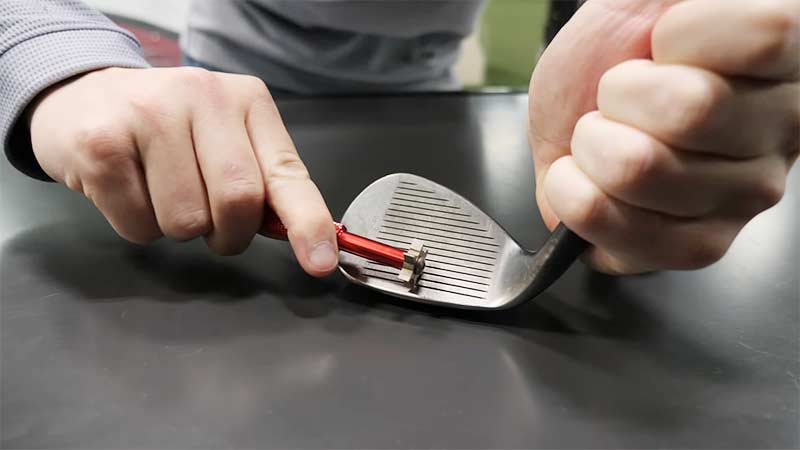Ever wondered why your golf shots lack the spin and control they once had? The secret might lie in the grooves of your club.
Sharpening your golf grooves can significantly enhance your game by restoring the spin performance of your wedges, leading to improved ball flight and accuracy.
In a recent test, 15 golfers hit shots using clubs with both unsharpened and sharpened grooves under controlled conditions. The results were clear: sharpened grooves provided noticeable improvements.
Whether you’re using a budget-friendly sharpener or a high-end precision tool, maintaining your club’s grooves can make a substantial difference in your play.
Understanding the materials and methods behind groove sharpeners can help you make an informed choice.
Most game-improvement irons are made of stainless steel, and the right sharpener can keep these clubs performing at their best. So, if you’re looking to up your game, it might be time to give those grooves a little attention.
Essential Tools and Materials
Sharpening your golf club grooves demands the right tools and protective gear to ensure both effectiveness and safety. Accurate selections here can significantly affect your results.
Types of Groove Sharpeners
Several types of groove sharpeners exist, each designed for different needs and preferences:
Manual Groove Sharpeners
These handheld tools let you manually scrape the grooves on your club. Manual sharpeners often have multiple heads to adjust for different groove sizes.
Electric Groove Sharpeners
Powered by electricity, these sharpeners provide consistent results with less physical effort. Electric versions work faster and can be ideal for frequent use.
Precision Groove Sharpeners
Designed for professionals, precision sharpeners offer highly accurate sharpening, ensuring compliance with USGA standards. These often feature micron-level adjustments for exact depth and width.
Safety Equipment
Proper safety equipment ensures you can sharpen grooves without risk:
Protective Gloves
Wear these to guard against accidental cuts from the sharpener or the club itself. Synthetic or rubberized gloves offer a good grip and protection.
Safety Glasses
Prevent metal shavings from injuring your eyes. Simple safety glasses suffice, offering clear vision and full coverage.
Workbench or Vise
Secure the club during the sharpening process to avoid slips that could cause injury. A firm workbench or a vise provides stability, enabling precise work with minimal risk.
Preparing Your Golf Club
Proper preparation of your golf club is essential before sharpening the grooves. Follow these steps to ensure optimal performance and legality.
Cleaning the Clubface
Start by thoroughly cleaning the clubface to remove dirt, grass, and other debris. Use warm water and mild soap along with a soft brush to scrub the grooves gently.
Be sure to rinse thoroughly and dry completely using a clean towel. This step ensures that no foreign material interferes with the sharpening process.
Next, examine the grooves closely to identify any signs of wear or damage. Use a golf groove sharpener, aligning it carefully with the grooves.
Apply gentle pressure and follow the manufacturer’s instructions to ensure even sharpening. Repeat this process for each groove on the clubface.
After sharpening, wipe down the clubface again to remove any metal filings or residue. Regularly sharpening your grooves can enhance spin and control, improving overall performance on the course.
Inspecting the Grooves
Inspect the grooves closely to assess wear and damage. Look for any dents, chips, or significant wear patterns.
Measure the depth and width of the grooves, ensuring they conform to USGA regulations, which state that grooves must be straight, parallel, and have a symmetrical cross-section. If the grooves are irregular or damaged, careful sharpening can restore their efficacy.
Using a groove sharpener, carefully follow the original groove lines to maintain the manufacturer’s specifications. Apply consistent pressure and make smooth, even strokes.
This will ensure optimal club performance on the course, enhancing spin and control. Always finish by cleaning the clubface and testing it to confirm the improved performance.
Step-by-Step Guide to Sharpening Golf Grooves
Sharpening golf grooves involves precision and care to ensure your club remains effective and legal. Follow these steps to achieve the best results.
Securing the Golf Club
Secure the golf club to a stable surface before starting. Use a vice with rubber inserts to prevent damage to the club shaft. Position the clubface so the grooves are easily accessible.
Next, select an appropriate groove sharpener or a specialized tool designed for groove maintenance. Gently run the tool through each groove, ensuring even and consistent pressure to restore the edges.
Make sure to follow the original groove patterns while sharpening. Clean off any debris with a soft brush and inspect the grooves under good lighting.
Finish by wiping the clubface with a damp cloth. This regular maintenance can enhance your shot precision and comply with golfing regulations.
Technique for Sharpening
Choose a suitable groove sharpener for your club. Insert the tool into the groove at the same angle as the original.
Apply consistent, moderate pressure and move the sharpener along the groove in straight strokes. Avoid altering the width, shape, or depth of the grooves to ensure the club remains conforming to USGA rules.
Regular maintenance not only enhances performance but also extends the lifespan of your golf clubs. Always clean the grooves after sharpening to remove any debris.
Checking Your Progress
After sharpening each groove, inspect the clubface to assess uniformity. Use a magnifying glass for a closer look. Clear any debris from the grooves and test the club on the practice range to evaluate performance improvements.
If the spin rate or accuracy deviates negatively, reassess your technique or consider professional assistance. Always ensure the grooves comply with current golf regulations before competitions.
Regular maintenance can prolong club performance and elevate your game, making it a worthwhile addition to your routine.
Tips for Effective Sharpening
Effective groove sharpening requires attention to detail and precision. Follow these tips to achieve optimal results.
Applying the Right Pressure
Consistent pressure ensures you remove just enough material without damaging the clubface. Apply firm, controlled strokes when using the groove sharpener.
Avoid pressing too hard, as this can widen or deepen the grooves beyond legal limits. The right amount of pressure restores the grooves’ original shape without compromising the club’s performance or adherence to USGA regulations.
After sharpening, clean the clubface thoroughly to remove any debris. Inspect the grooves for uniformity and check if they meet the necessary specifications. A final touch with a light oil can help protect against rust.
Maintaining Consistent Angles
Keep the sharpening tool at a consistent angle relative to the groove’s original orientation. Inconsistent angles can create uneven grooves, adversely affecting spin rates and ball control.
Use a guide or tool with angle markings if necessary to retain uniformity. Consistency in angle maintains the design integrity and optimizes performance, ensuring that every groove functions as intended.
After sharpening, it’s crucial to clean the clubhead thoroughly to remove any metal filings. This prevents potential damage to the ball and ensures maximum spin.
Regularly maintaining groove sharpness gives golfers a significant advantage on the course by enhancing shot accuracy and control. Always check with your club manufacturer’s guidelines to avoid voiding any warranties.
Common Issues and Troubleshooting
Encountering issues while sharpening golf grooves is common. Addressing these issues ensures that your clubs remain effective and conform to regulations.
Uneven Groove Depths
Uneven groove depths often occur if inconsistent pressure is applied during sharpening. To avoid this, ensure that you use a calibrated groove sharpener and apply uniform pressure along the entire groove.
For example, if the tool drags more in some areas, you might be pressing harder or the groove may have different wear.
Checking each groove individually guarantees a balanced depth across the clubface, preventing performance issues during gameplay.
Over-Sharpening
Over-sharpening leads to grooves becoming too deep or wide, which renders the club non-conforming under USGA regulations.
To prevent this, use a depth control tool that matches the original specifications of your club’s grooves. If scraping metal, monitor the amount removed and stop periodically to measure the groove depth.
A slight modification can lead to significant discrepancies. Follow the groove sharpener instructions carefully, focusing on restoring rather than enhancing the grooves to their initial conditions.
Post-Sharpening Steps
After sharpening your golf grooves, follow these essential steps to ensure optimal performance and longevity of your clubs.
Final Cleaning
Ensure all metal shavings and debris are removed from the clubface. Use a soft brush and warm water to scrub the grooves gently.
This step prevents any residue from affecting future shots and maintains the integrity of the sharpened grooves. Dry thoroughly with a clean cloth to avoid any moisture buildup.
Once dry, apply a protective layer of club oil to prevent rust. Regularly inspect and maintain the grooves to ensure optimal performance. Properly sharpened grooves can significantly enhance shot control.
Applying a Protective Coating
Apply a light layer of rust-inhibitor spray to the clubface. This coating protects the metal and prolongs the sharpness of the grooves.
Let the spray dry completely before storing the club in your bag. This preventive measure helps maintain the performance of your sharpened grooves and guards against potential damage from environmental factors.
Regular maintenance is key to ensuring the longevity and effectiveness of your golf clubs. Additionally, consider wiping down the clubface after each use to remove dirt and debris.
This practice will help keep the grooves in optimal condition, allowing for enhanced spin and control on the course.
Legal Considerations and Compliance
Adhering to golf club regulations ensures fair play and prevents disqualification in tournaments. Understanding the rules is vital for any golfer considering groove sharpening.
Understanding Golf Club Regulations
Regional and international standards govern the specifications for golf club grooves. The USGA (United States Golf Association) and R&A (The Royal and Ancient Golf Club) set these standards, focusing on groove width, depth, and spacing.
Grooves must be straight and parallel. Additionally, grooves require a symmetrical cross-section with non-converging sides. Any alteration must comply with these criteria to avoid penalties during tournament inspections.
It is crucial to remember that mid-round groove sharpening using tools like the Caddy Splash Groove Sharpener is not permitted under USGA rules. This restriction helps maintain consistency and fairness throughout the game.
Frequently Asked Questions
Why is sharpening golf club grooves important?
Sharpening golf club grooves improves spin performance, ball flight, and accuracy, helping golfers achieve better control over their shots.
What tools are used for sharpening golf club grooves?
Manual and electric sharpeners are commonly used for sharpening golf club grooves.
Are there specific regulations I should be aware of when sharpening grooves?
Yes, ensure your club conforms to USGA and R&A regulations to avoid disqualification in tournaments.
How can I identify if my golf club grooves need sharpening?
If you notice a loss in spin control, ball flight, or accuracy, it’s a sign that your grooves may need sharpening.
Are there prohibitions regarding groove sharpening during a game?
Yes, mid-round sharpening is prohibited to maintain fairness in the game. Always check your equipment before starting a round.
Conclusion
Sharpening your golf grooves can significantly enhance your game by improving spin performance and accuracy.
With the right tools and safety measures, you can maintain your clubs in top condition. Always ensure compliance with USGA and R&A regulations to avoid any penalties.
Proper preparation and post-sharpening care are crucial for longevity and performance. By understanding groove specifications and adhering to the rules, you can enjoy a fair and competitive game.
You can use specialized groove sharpeners or send your clubs to a professional service for optimal results. Regularly inspect your grooves for signs of wear and clean them after each use to maintain peak performance.








Colin McCarthy